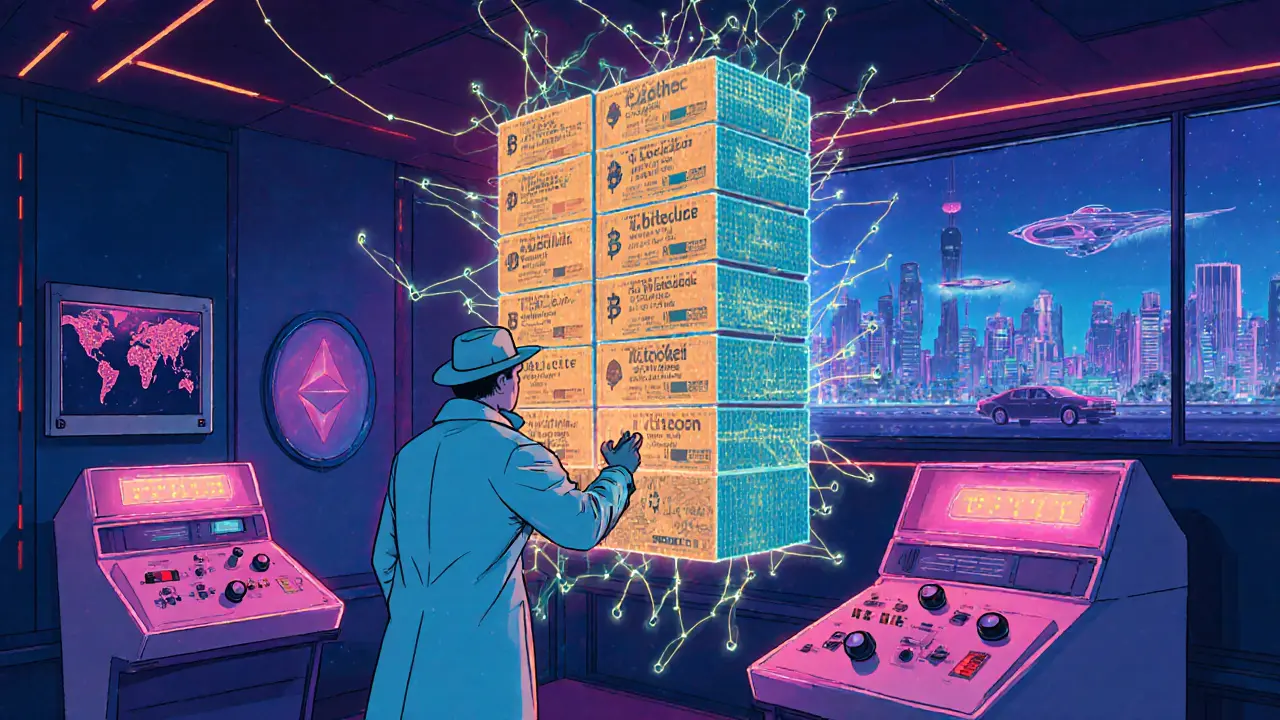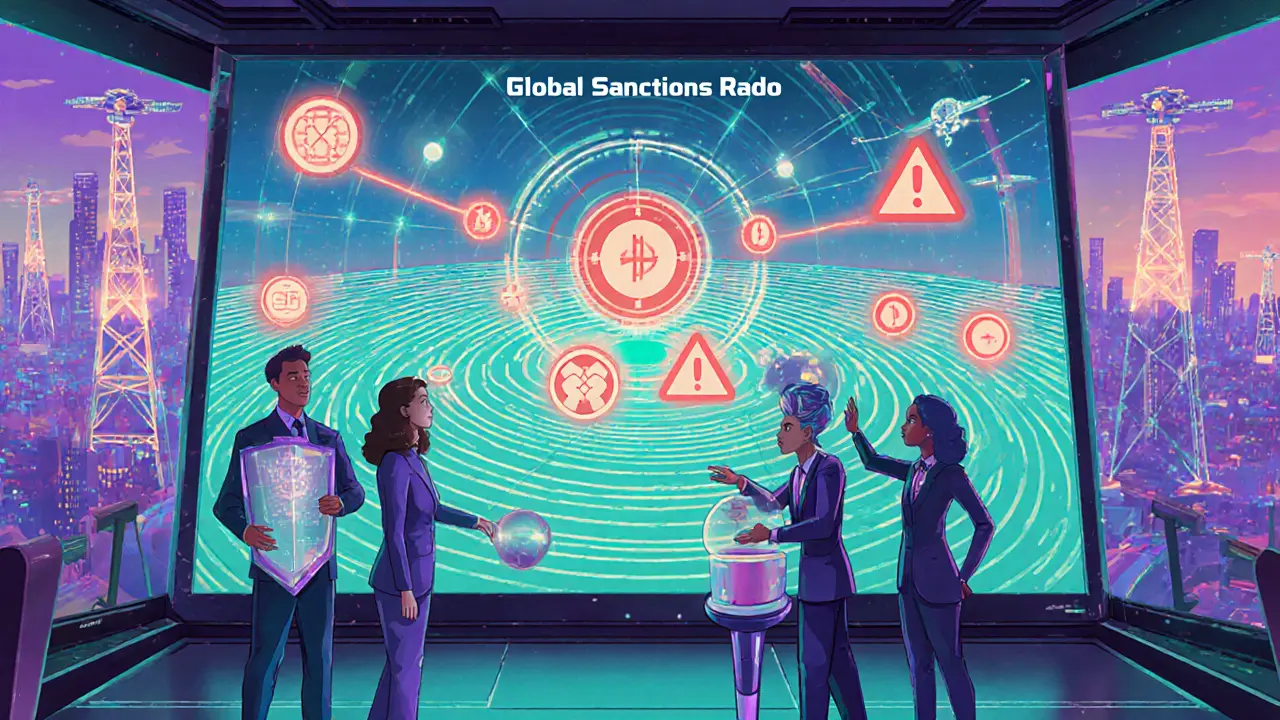How Authorities Use Blockchain Forensics for Crypto Sanctions Detection
 Oct, 3 2025
Oct, 3 2025
Crypto Sanctions Risk Calculator
Assess Transaction Risk
Enter transaction details to see how blockchain forensics tools identify sanctions evasion patterns.
Risk Assessment Results
Enter transaction details to see the risk assessment.
Quick Takeaways
- Blockchain forensics turns the public ledger into a powerful investigative tool for tracking illicit crypto flows.
- Modern platforms combine graph‑analysis, AI, and cross‑chain tracing to spot sanctions evasion in real time.
- The Helix case showed how manual tracing evolved into automated pattern detection like MPOCryptoML.
- Key players - Elliptic, Chainalysis, CipherTrace - differ in coverage, integration depth, and pricing models.
- Successful implementation requires trained analysts, secure data pipelines, and clear regulatory protocols.
When a crime ring tries to sidestep economic sanctions with Bitcoin, Ether, or a newer token, investigators now have a clear path to follow - thanks to Blockchain forensics the discipline that maps, analyzes, and attributes cryptocurrency transactions on distributed ledgers. This article walks through the core methods authorities use, the tech that powers them, and the practical steps needed to keep sanctions enforcement effective in 2025.
Why Blockchain Forensics Matters for Sanctions
Sanctions are legal tools designed to freeze assets, restrict trade, and pressure rogue actors. Cryptocurrencies challenge those tools because they are borderless, pseudonymous, and can hop across dozens of blockchains in seconds. Without a way to link a wallet address to a sanctioned entity, regulators risk blind spots that criminals exploit.
Blockchain forensics plugs that gap by turning the immutable transaction record into a searchable evidence trail. Every transfer, smart‑contract call, or token swap leaves a digital breadcrumb that can be collected, visualized, and matched against sanctions lists such as OFAC, EU, or UN embargoes.
Core Techniques Behind the Investigation
Authorities combine traditional law‑enforcement methods with several technical pillars:
- Address clustering. By analyzing shared inputs, change‑address patterns, and transaction timings, tools group seemingly unrelated addresses into a single entity.
- Graph‑based risk scoring. Nodes (wallets) and edges (transactions) form a graph that can be fed into algorithms like Personalized PageRank to highlight high‑risk flows.
- Cross‑chain correlation. Bridges, wrapped tokens, and atomic swaps create links between Bitcoin, Ethereum, BNB Chain, and newer networks such as ICP.
- Machine‑learning anomaly detection. Models learn typical transaction behavior and flag outliers that may indicate mixers or layered laundering.
- Real‑time monitoring. APIs push alerts to compliance dashboards the moment a flagged address appears in a new transaction.
One standout innovation is the MPOCryptoML an end‑to‑end multi‑pattern machine‑learning framework for detecting complex laundering schemes across blockchains. It blends multi‑source Personalized PageRank with pattern libraries covering fan‑in/fan‑out, bipartite, gather‑scatter, and stack formations. In benchmark tests MPOCryptoML improved precision by 9.13 % and recall by 10.16 % over seven leading baselines, making it a game‑changer for large‑scale investigations.
From Manual Tracing to Automated Platforms - The Helix Example
The 2016 Helix investigation highlighted the limits of manual analysis. Larry Dean Harmon, operating a darknet drug market, laundered over $300 million by moving Bitcoin through the Helix mixing service, then funneling proceeds to exchanges. Investigators had to sift through hundreds of thousands of transactions to spot commission‑payment patterns.
Fast‑forward to 2025: the same workflow is now automated. An analyst uploads a suspect address into an analytics platform, selects “Mixing Service” as a risk tag, and the system instantly maps the mixed output, flags downstream addresses, and correlates them with known exchange wallets. The time‑to‑insight drops from weeks to minutes, and the evidence chain is automatically logged for court admissibility.

Major Forensic Platforms and Their Features
| Platform | Cross‑chain coverage | AI/ML risk scoring | Sanctions list integration | Typical pricing (USD per month) |
|---|---|---|---|---|
| Elliptic | 30+ major chains + Layer‑2 | Custom graph‑ML + pattern library | OFAC, EU, UN, UK, custom | $12,000‑$30,000 |
| Chainalysis | 25+ chains, focus on Bitcoin/Eth | Behavioral clustering + transaction typology | OFAC, EU, AML‑CFT, custom | $10,000‑$25,000 |
| CipherTrace | 20+ chains, strong DeFi support | Neural‑network risk scores | OFAC, EU, FATF‑derived | $8,000‑$22,000 |
All three platforms support real‑time API feeds, but their strengths differ. Elliptic offers the deepest cross‑chain integration and a dedicated sanctions‑evasion module, making it a favorite among governmental agencies. Chainalysis shines in investigative visualizations, while CipherTrace leans heavily into DeFi protocol parsing.
Detecting Sanctions Evasion - Tactics and Counter‑Measures
TRM Labs identified five recurring methods criminals use to dodge sanctions. While the full list is proprietary, the most common patterns include:
- Layered mixing through services like Tornado Cash a privacy‑preserving Ethereum mixer or Wasabi Wallet a Bitcoin CoinJoin implementation.
- Cross‑chain swaps that move value onto blockchains with weaker monitoring.
- Use of decentralized exchanges (DEXs) that lack KYC.
- False‑positive address reuse to blend illicit funds with legitimate traffic.
- Obfuscation via smart‑contract wallets that split and recombine tokens.
Effective detection relies on continuous address screening, transaction pattern matching, and real‑time alerts when a flagged address appears in a new chain hop. Platforms now offer "sanctions watchlists" that automatically block transfers to or from flagged entities, reducing the window for abuse.
Implementation Roadmap for Law‑Enforcement and Regulators
Setting up a blockchain forensics capability isn’t just about buying software. Agencies need a structured rollout:
- Define the legal scope. Identify which sanctions regimes apply, and draft data‑retention policies that satisfy both privacy laws and evidentiary standards.
- Build a skilled team. Hire analysts with backgrounds in finance, cyber‑crime, and data science. Most vendors, like Elliptic, provide certification programs.
- Integrate with existing AML systems. Connect blockchain alerts to the agency’s case‑management platform via APIs.
- Establish SOPs for evidence collection. Capture block hashes, transaction IDs, and node snapshots to ensure chain‑of‑custody.
- Run pilot investigations. Start with known sanction‑evading cases to fine‑tune risk thresholds.
- Scale and audit. Periodically review detection accuracy, update watchlists, and conduct external audits for compliance.
Collaboration is also key. The Internet Watch Foundation partners with blockchain analytics firms to block illicit crypto payments for child‑exploitation content illustrates how law‑enforcement, NGOs, and tech vendors can work together.

Future Trends Shaping Crypto Sanctions Enforcement
Three developments will shape the next five years:
- Zero‑knowledge proof detection. As zk‑SNARKs become mainstream, analysts will need specialized heuristics to spot misuse without breaking privacy guarantees.
- AI‑driven predictive analytics. Models will not only flag suspicious transactions but also predict likely sanction‑evasion routes before they happen.
- Regulatory data‑sharing consortia. International bodies are drafting standards for secure, privacy‑preserving sharing of blockchain risk data, which could lead to a global “sanctions radar”.
Staying ahead means investing in adaptable platforms, continuous analyst training, and policy frameworks that allow rapid response to emerging tech.
Quick Checklist for Authorities
- Enroll analysts in vendor‑provided forensic certification (Elliptic Academy, Chainalysis Academy).
- Integrate real‑time API feeds from at least two forensic platforms for redundancy.
- Maintain up‑to‑date sanctions watchlists from OFAC, EU, UN, and any national authority.
- Document every investigative step to preserve chain‑of‑custody for court use.
- Review and refresh detection rules quarterly to cover new mixers and cross‑chain bridges.
Frequently Asked Questions
What is the difference between blockchain forensics and regular crypto compliance?
Blockchain forensics focuses on tracing and attributing specific transactions, often to build a criminal case, while crypto compliance is a broader risk‑management program that includes KYC, AML policies, and periodic reporting.
Can sanctions‑evasion detection work in real time?
Yes. Most commercial platforms provide webhook or streaming API endpoints that push alerts the moment a transaction involves a flagged address or passes a risk‑score threshold.
How do mixers like Tornado Cash affect investigations?
Mixers break the link between input and output addresses. Forensics tools use clustering, timing analysis, and heuristic pattern matching to infer probable paths, but absolute certainty may be harder to achieve.
Are blockchain forensic findings admissible in court?
When the analysis follows proper chain‑of‑custody procedures, captures immutable block data, and includes expert testimony, courts have accepted it as reliable evidence in multiple jurisdictions.
What budget should a midsize agency allocate for a forensic solution?
Licensing usually starts around $8,000 per month for basic coverage, but a full‑scale deployment with cross‑chain support and dedicated analyst training can reach $30,000‑$50,000 annually.
Blockchain forensics is no longer a niche hobby; it’s a critical pillar of modern sanctions enforcement. By mastering the tools, techniques, and organizational processes described above, authorities can turn the open ledger from a haven for evaders into a searchable record that helps keep illicit crypto money off the global financial system.
paul boland
October 23, 2025 AT 19:10Sean Hawkins
October 23, 2025 AT 20:53Susan Bari
October 24, 2025 AT 09:42Daisy Family
October 24, 2025 AT 21:15Chris Pratt
October 25, 2025 AT 10:11Marlie Ledesma
October 26, 2025 AT 10:03Peter Brask
October 27, 2025 AT 05:47harrison houghton
October 27, 2025 AT 06:54Niki Burandt
October 27, 2025 AT 16:18Jason Roland
October 27, 2025 AT 16:25vonley smith
October 28, 2025 AT 10:22rachel terry
October 29, 2025 AT 03:08DINESH YADAV
October 29, 2025 AT 12:31Bert Martin
October 29, 2025 AT 18:37Ray Dalton
October 29, 2025 AT 21:40Karen Donahue
October 30, 2025 AT 06:53Kyle Waitkunas
October 30, 2025 AT 23:24Paul Kotze
October 31, 2025 AT 19:13Melodye Drake
November 1, 2025 AT 11:04Trent Mercer
November 2, 2025 AT 01:41